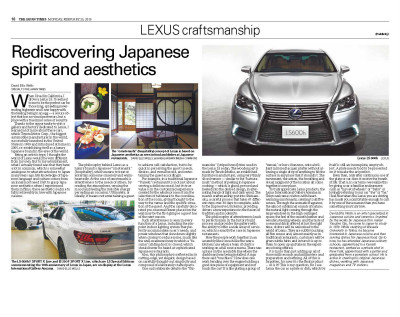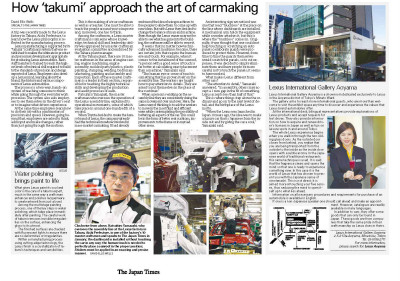.
David Wells Profile
デヴィット エリス ウェルス
オレゴン大学在学中、映画専攻したことで,小津安二郎監督作品に出会う。
彼の作品を通して日本に興味を持ち始めた。
自分が体験したことのない空気がそのスクリーンの中に満ちていたからだ。
1979年、興味の赴くままに日本行きを決意。早稲田国際学部に入学。
そして運命の日本料理に出会う。
そこにはやはり見たことのない素材、色、形、香り、そして調理の技と盛り付けのさえ、空間、器、時の流れ、幼少の頃からアートを学び映画を学んできた自分にとって、日本料理には、現代アートそのすべて要素があることに驚かされ、奥深いアートの力を感じた。
以後、2つの料理学校、料亭の修行、プラベートシェフ時代、陶芸家のもとで野焼きもの修行、窯業大学校での絵付けをすることになる。
今、日本料理という表現素材を通じて、五感を揺さぶるような小宇宙を創りたいと強く望む。素材、器、空間、自然、感動、喜び。
そしてそれは、地球の上のどこでもどんな素材であっても、自分が目指すアートの世界を可能にすると信じて疑わない。
.
David Wells Profile
DAVID ELLIS WELLS
OCCUPATION: Japanese chef/potter
BIRTH DATE: October 31, 1957 Halloween
PLACE OF BIRTH: Spartanburg, South Carolina
EDUCATION: University of Oregon / Waseda University
Tokyo School of Cooking / Tsuji School of Cooking
Saga Prefectural School of Porcelain
JAPANESE AKA: Aoi me no Rosanjin or the blue eyed Rosanjin
http://en.wikipedia.org/wiki/Rosanjin
Devitto, Debito, De-bi
AWARDS AND HONORS
Scholastic Art Award
Best Art Student Award
Adachi Fish Market Achievement Award
VIDEOS
SYNOPSIS
Early Life
Early Career
Education: Japan, US
Periods
People
Influences
Turning Point
In Japan he is called the Aoi Me Rosanjin or the blue-eyed Rosanjin
He was a very successful chef and potter.
Early Life
David is the second of 4 boys. His father, Ellis Richeburg, was a sergeant in the marines as well as an engineer, who could build and fix almost anything. Before David had turned 10, he had built 4 motor powered go-carts himself. These were his first toys. By 15, David was driving himself to school by car.
His mother, Shirley Jean Quinn, was one of 13 children and an athlete, who gave up her dream of becoming a basketball star to get married. She then went on to manage a bank. His parents divorced when David was young boy.
people
Shizuo Tsuji, The head of The Culinary Institute, Osaka, Japan
He taught me how to taste.
Tsuji Kaiichi, (The two are unrelated) He was one of the more famous Kaiseki chefs as well as well known author.
His precise but simplistic food presentation.
Early Career
David worked delivering newspapers as a child, then ran an ice cream stand and throughout high school managed a carwash. He always had an eye for design, and at 13 he began taking private art lessons. “The blank canvas is the only place where true freedom lies!” Thus began the inspiration for his creative career.
Western Education > USA
Basic education was of little interest to him until his third grade teacher asked
the class to listen to a score of classical music and then respond to it by painting a picture. David was inspired by the process of how sound could be changed into a literal piece of artwork.
However, design rather than art was the path he chose. Instead of sticking to one particular medium David is rather drawn to “expression through a particular medium’s properties.“ He received the best art student award in junior high and a Scholastic Art Award in high school.
In college he studied drawing, sculpture and film. During this time he was introduced to the films of Japanese director Yasujiro Ozu. The film, The Story of Tokyo, challenged his aesthetic eye which in turn challenged David himself to go out and search for a new form of aesthetics.
Asian Education > Japan
In his junior year he went on a one-year student exchange program to Waseda University in Tokyo. Totally taken by Japanese aesthetics, he stayed on instead of returning to Oregon. David was the only foreign student to go on to the language laboratory at this prestigious school. It was at this time that he found a subject that would change the rest of his life: Japanese Cuisine. Even while he was living in Japan he found it was not only that the food pleased his eye, but also that this was the food that he began to truly crave out of hunger. He first discovered the impact the cuisine had made on him by participating in the annual speech contest for foreigners in Japanese. He thought that once he returned to the United States, he would not be able to live without the Japanese cuisine that he had come to love. He realized the only way to get it was to learn how to make it himself.
After this discovery he enrolled in a Japanese culinary school. Upon graduating, he entered a two-year apprenticeship in a Kaiseki restaurant in downtown Tokyo, not knowing that after relocating later to New York City he would be asked to return to Osaka, Japan to study the Kansai style of cooking at Tsuji. This is where he was taught how to taste.
Adult Career
David began his cooking career as a private chef for the chairman of the Dreyfus Corporation. This period lasted more than eight years. He considers this time a once in a lifetime opportunity, because for two weeks each year, five Tsuji teachers/chefs (French, Italian, Chinese, Japanese and a pastry chef) were sent to New York from Osaka to cook and teach him man-to-man their more well received dishes.
Turning Point
While he was working in New York, the death of a childhood friend made David realize that one must pursue one’s ambitions. He packed his bags and headed back to Japan. This time it was in pursuit of an intensive study of plate making. This turned into two apprenticeships in Mino, the opening of his own ceramic studio and his enrollment in the state run porcelain school in Arita. This is where the great Imari wares were produced and it is where David completed yet another apprenticeship.
Objective
David’s overall objective is to create theme-oriented dinner events and all of the utensils that go along with it. It is difficult for even him to explain, but he somehow develops themes that are, as he says, a result of the moment: a mirror of sorts, a reflection of everything that has instigated a response whether it be history or a concept. It could be “us, here at this time and place” or even the moon.
He realizes these concepts through whatever means possible, although first and foremost are the organic seasonal ingredients that will go onto his handcrafted plates. They are the heart and soul that together with the plates, make his dinners complete.
Completion
Completion of both food and plate are only realized when the two have come together. From the moment of completion the hungry viewer has before him an object that he admires, which then becomes an object for consumption, the act of destruction, with nothing remaining but the plate. This process is also in its way a completion.
But there is another more personal completion that David holds close:
The Plate
When David is creating his dinners he says that the plate does not need to be in front of him. It is intuitively known. He says that he can see every facet of it. His measurements are not made by numbers but by hand. The movement of his hand decides all. Through the length of his fingers, the curvature of his hand, the roundness of his finger tips. David’s hand is his intuitive measuring stick. Of course, this is invisible to everyone and only lasts for a single moment in time. However, it is what he considers to be the pinnacle of aesthetics.
The Elements
Paper, glass, clay, porcelain, metal, fabric, lacquer, leather, wood and leaves from nature all have their own significant role in his dinners whether they play the lead or take on a supporting role. Nature rules all, with the season always having the final say on what is going to be presented on the plate.
Menus
When it comes to creating a menu, David considers it an educational process because of the many elements involved. Even though in the west the names of the months do not change, the weather is always changing. One cannot rely on past menus. One must look at the food products of the present and constantly be thinking about the future. Writing menus on paper is a good start, but a written menu is not written in stone. It only gives us an idea of what is going to be served. The superior ingredient is the final decision maker.
For this reason one must be in control of the menu making process and at the same time be open to all other criteria.
PRINTED MATERIAL
Japanese Foodways Past and Present
Newsweek Japan
Articles for periodicals in Japanese on Japanese culinary culture.
Articles
TOYOTAレクサスとデヴィットウェルス
http://lexus.jp/international/features/lexus_craftsmanship/index.html
2015年2月23日 ジャパンタイムズ新聞で一ページの広告です。
和のLEXUSとDAVIDの日本料理の世界の出会い。
TOYOTA LEXUS & DAVID WELLS
This is the full, one page advertisement that was in The Japan Times on February 23rd. Toyota was looking for someone with an understanding of the aesthetics and the culture, that is how we came together.
David Wells:NHK World "Journeys in Japan"
David Wells:NHK World "Journeys in Japan" Ancient city of Kamakura
David Wells:NHK World "Journeys in Japan"
David Wells:NHK World "Journeys in Japan" Celebrating the landscape of Azumino
David Wells:NHK World
"Journeys in Japan"
"Journeys in Japan"
Journeys in Japan: Echizen - The World Of Washi 和紙
David Wells:NHK World
"Journeys in Japan"
"Journeys in Japan"
Journeys in Japan: Nagasaki
David Wells:NHK World
"Journeys in Japan"
"Journeys in Japan"
Journeys in Japan: Ibaraki
イチオしNIPPON
David Wells


